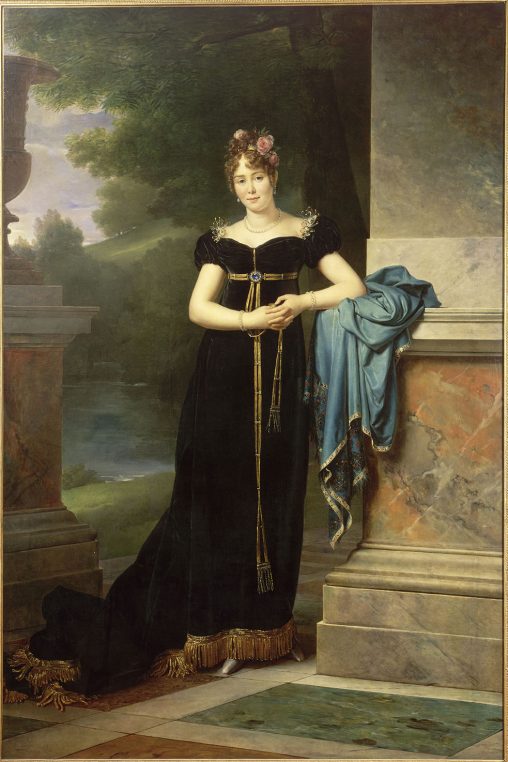
Napoleon’s funeral chariot in Sainte Hélène, ca 1815, wood an metal, Château de Malmaison et Bois-Préau
With la Grande Halle de la Villette, a gigantic cultural space set in the former meat market, in the North of Paris, Emperor Napoléon has found a perfect celebration spot two hundred years after he died on the island of Sainte Hélène 2 600 kms west of Angola… The exhibition which is just opening there instead of at the Grand Palais (under renovation), was set in the most lavish way with a group of scenographers and architects, worth the coronation itself. It is the perfect show to go and see with children or foreign friends. The two outstanding moments are the huge screen reproducing the animated version of the Sacre in Notre Dame, a painting by Jacques Louis David which could not come from the Louvre because of its size (621 X 979 cm). And the simple trolley which carried the emperor’s body in Sainte Hélène.

The room of the throne with François Gérard’s portrait of Napoleon, the gilt wooden throne by Chalgrin and Desmalter and a superb pair of “torchères”, from château de Saint Cloud
But as a friend mentioned during the visit, what is extraordinary is to find in one spot the treasures kept by Musée du Louvre, Musée de Versailles, Château de Malmaison, Musée de l’Armée, Mobilier National and Fondation Napoléon. The most intimate objects are exhibited along the most official ones in a chronological way which outlines first his education at the military school of Brienne for five years. We see his books and hear about his natural authority which was obvious already. Explanatory panels are numerous throughout the show and it’s very easy to navigate through the different periods, the Revolution, the Italian and Egyptian campaigns, the Republic and his love for America,teh Russian campaign, the reestablishment of slavery and his life as Emperor followed by defeats and exile.

François Gérard, Marie Walewska (1789-1817), ca 1810, © Paris – musée de l’Armée, Dist. Rmn – Grand Palais / Philippe Sébert
A reproduction of the Pierre de Rosette (Rosetta Stone kept at the British Museum), the stone which allowed Champollion to understand the hieroglyphs through a Greek translation, is shown as a sign of the success of the scientific expeditions which followed Napoleon in Egypt. The exhibition is punctuated by numerous videos like Lou Doillon reading Napoleon’s love letters to Joséphine, black writers discussing slavery, life and death in the army by famous historians. The films “Le Colonel Chabert” by Yves Angelo and “Waterloo” by Bondartchouk as well as Abel Gance’s “Napoleon” are part of the show and many uniforms and precious swords are exhibited along, making every scene very lively.
The use of very visual scenes and beautiful objects, makes the whole exhibition very successful. It was a delight to see Marie Walewska‘s portrait by Gérard. This Polish lady whom Napoleon had met at a ball given by Talleyrand in Warsaw in 1807, had an affair with him. She visited the emperor with their son Alexander (born 1810) in Elba in 2014. The Emperor had recognized the child and given them both enough wealth to live on but she unfortunately died at 31.
Napoleon was a great lover of the arts and the number of excellent portraits shown in the alleys is a proof of it. His family is prominently displayed as he made sure to use his brothers as sovereigns all around Europe. But silver and porcelain are also very present and Fondation Napoléon lent a number of decorative items like the precious chest and writing table made by Levasseur for Spanish minister Manuel Godoy. I liked seeing again this “bivouac”, the simple camping bed which is exhibited at Malmaison all year round.
There are numerous paintings of his victories in Eylau in 1807, in Lodi in 1796, in Saragosse in 1809, and a very moving statue of his last moments in Sainte Hélène.
The exhibition is a success because it is very didactic and well explained. You see the contradictions in the character and in the reign. His great power and love for luxury as well as his lonely end of life. You realize how much he did for the arts, and for the law. There is a lot of space in the show as if thousands of visitors were expected. So book now if you want to excapeteh crowds…

Jean-François Chalgrin and François-Honoré Jacob-Desmalter, Trône of the Emperor Napoléon 1er Bonaparte, 1804-1805 Sénat de la République française © Sénat, G. Butet
Until December 19, Grande Halle de la Villette.
Share this Post




3 Comments on “Napoléon in full majesty at la Villette”
Excellent review of the exhibit. Did you notice the tapis under his camp bed was leopard skin? Very thrilling exhibition.
Exposition à voir Parfaite
thank you for this review!